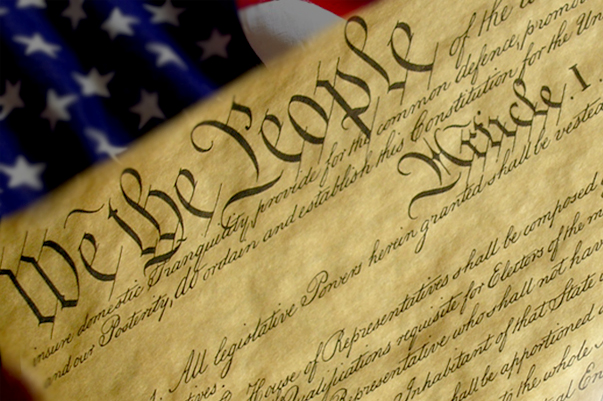Buchaniec: Laws should match our present, not our history
The United States Constitution.
May 14, 2019
In a letter to James Madison, Thomas Jefferson said that he believed the Constitution ought to have a deadline — 19 years, to be exact.
At the time Jefferson’s letter was penned, a generational change occurred approximately every 19 years. According to Jefferson, this generational transition should correspond to a change in the laws, including the very basis of our government — the Constitution. Yet centuries after its ratification, the U.S. continues to work within the same framework it did when it was first approved. While some of those principles continue to have merit, not all are applicable to the world that we live in today.
In the 230 years since the Constitution was ratified, people have walked on the moon, mapped the human genome and linked almost every corner of the globe through the internet. The world at large has transformed itself in ways inconceivable to those living in the time of the founding fathers, with the U.S. at the forefront of the aforementioned, and countless other, technological advances.
Our society looks vastly different than it has historically, but for the most part, our Constitution has remained the same — it was built for life in 1789, not 2019. What might have worked then fails to match the problems we face today. Jefferson wanted Earth to belong to the living, and not to the dead, but for the past few centuries, we have continued to define ourselves by our history and not our present.
The Second Amendment, for instance, was ratified in 1791, and while those in charge of its wording might have anticipated development in terms of gun technology, they most certainly did not have the modern weaponry we know today in mind. At that time, a musket — the most popular weapon of choice — could fire approximately three rounds per minute.
Two-hundred twenty-eight years later, mass shootings bombard our headlines and overall gun violence continues to plague the lives of citizens. Unlike the musket from 1791, an AR-15 — the type of gun used in the shooting at Marjory Stoneman Douglas High School, for example — has the ability to fire up to 400 rounds per minute with a bump stock. Yet, the same right of ownership applies to both. Every time we broach the topic of gun reform, people use the Second Amendment and the right to bear arms as the main defense for gun ownership, but there it is important to note that a musket is not an automatic weapon.
Why should the Second Amendment apply to a weapon that was most likely beyond the imaginations of even the most forward-looking legislators from 229 years ago? If they saw what we see on a weekly basis — the carnage and bloodshed, the devastation and tragedy — would they have worded the Bill of Rights in the same manner that they did?
Furthermore, if those same legislators they saw the modern technology — aircraft carriers, nuclear submarines and hacking — utilized by the military and the NSA, would they still believe guns would protect people against governmental tyranny, which is the reason the 2nd Amendment was written in the first place?
I am not arguing that the right to bear arms shouldn’t exist, but rather that it should be reevaluated under a modern perspective, especially in light of modern technology.
Along the same lines, did the Founding Fathers anticipate the internet when shaping the First Amendment? Did they think about the age of smartphones when looking at when exactly a search warrant can be issued, as is detailed in the Fourth? Although the Constitution can be amended, the complex process for doing so has historically limited the number of alterations, and the process for proposing even the most minute of changes through amendment is automatically met with groans of exasperation.
Furthermore, Jefferson expressed in his letter the importance of the present in shaping the law of the land. In 2019, our present is one defined by more inclusivity than has been seen at any other point in our history — inclusivity that should be considered in our laws. Although the Constitution applies to all citizens, not all citizens had their voice reflected in the rules they’re supposed to abide by.
Why should a document, which was entirely written by a group of land-owning white men from over 200 years ago, apply to women in 2019? To black citizens? To everyone excluded during the initial constitutional conventions?
If we give our Constitution, or maybe even all legislation, an expiration date — say every 50 years instead of Jefferson’s 19 — we would be forced to revisit laws instead of waiting for someone to propose an amendment or a bill in Congress. We would be forced to evaluate the issue that was at the course of the initial legislation and the ways that the problem has evolved over time.
I do not think the Constitution should be set in stone, rather, it should be a document that is regularly revisited and revised. We should be able to craft a document that suits life today, and while there might be some overlap in regards to rights our ancestors valued and ones we believe we ought to have, it is a conversation worth having. The Founding Fathers were not perfect and we shouldn’t view their work as such either.
In 2019, life is different than it was in 1789 — the framework for our democracy should be, too.
Catherine Buchaniec is a Medill first-year. She can be contacted at [email protected]. If you would like to respond publicly to this op-ed, send a Letter to the Editor to [email protected]. The views expressed in this piece do not necessarily reflect the views of all staff members of The Daily Northwestern.


